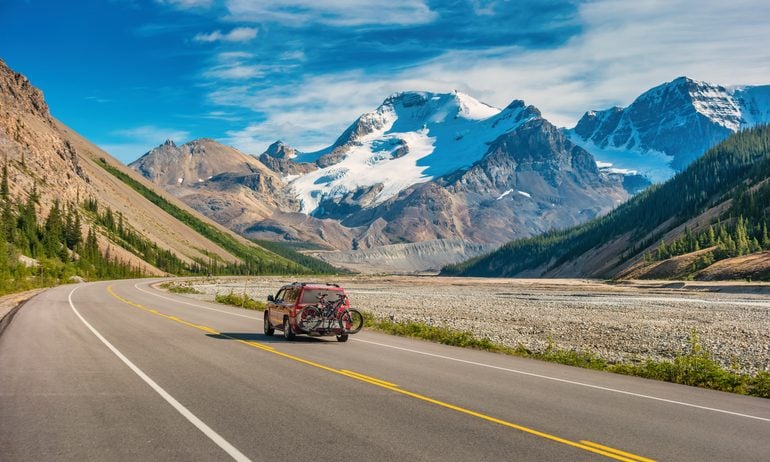U.S.-Canada Border Crossing: What You Need to Know
To cross the border, you'll need documentation of full vaccination and your travel documents.

Many or all of the products on this page are from partners who compensate us when you click to or take an action on their website, but this does not influence our evaluations or ratings. Our opinions are our own.
Borders between the U.S. and Canada recently reopened to travelers more than a year after having closed due to COVID-19. Now, many who are eager to explore our neighbor to the north are left wondering what’s involved in a border crossing and what guidelines they’ll need to adhere to for a successful journey.
If you’re anxious to visit Montreal, Toronto, Vancouver or Calgary, here’s what to know to plan your U.S.-Canada border crossing, whether by land, air or sea.
Who can travel from the U.S. to Canada?
Currently, Canadian borders are open to all U.S. citizens wishing to enter regardless of vaccination status. However, the requirements for entry will vary based on your vaccination status.
Fully vaccinated travelers no longer need to provide a negative COVID test for entry, but must still use the ArriveCAN app to submit mandatory entry information, including proof of vaccination, at least 72 hours prior to arrival and/or before boarding a cruise ship destined for Canada.
Not fully vaccinated? You won’t be able to visit Canada if you’re traveling for discretionary or leisure purposes. If you don't qualify as a fully vaccinated traveler but still need to travel to Canada for reasons other than leisure, you’ll be required to quarantine for 14 days, take a molecular COVID test, and register for a COVID test upon your arrival in the country, which you can do in advance to save time.
» Learn more: What COVID test is required for travel?
How many border crossings are there between the U.S. and Canada?
There are more than 100 land border crossings between the U.S. and Canada, and wait time to cross can vary widely.
At most crossings, how long you wait depends on the time of day and the day of the week. Some crossings have little to no delay at off-peak travel times, and others, like Buffalo, New York, can log wait times around 40 minutes.
If you want to set appropriate expectations for how long it takes to cross the U.S.-Canada border, check the Government of Canada website, which is updated hourly.
Checklist for a U.S.-Canada border crossing
If you're fully vaccinated and traveling to Canada, whether by car, plane or boat, you still have to follow certain protocols. To meet entry requirements, you must:
Have no symptoms of COVID-19.
Have received all doses of a COVID-19 vaccine at least 14 full days before you enter Canada.
Upload your proof of vaccination in ArriveCAN, an app that provides border crossing info and stores important documentation.
Have your required entry documents.
NOTE: As of April 1, 2022, fully vaccinated travelers no longer need to provide a negative test for entry.
» Learn more: 4 differences between a passport book and card
If you don’t meet all the requirements of a fully vaccinated traveler, you’ll have to quarantine for 14 days upon arrival. You may also be selected for a random arrival test at some airports and land crossings. These may take place at the airport or a designated testing site, or you may be provided with a do-it-yourself kit that you can send in once you arrive at your final destination.
Special cases for Alaska residents
If you live in Alaska, you may sometimes have to drive through Canada to get to certain regions of the state. Unvaccinated Alaska residents who must pass through Canada for necessary purposes (i.e. not for leisure or recreation) may do so without pre-entry and arrival COVID tests, but they must remain in their vehicle while driving through Canada. They'll also likely be given a specimen collection kit when they cross a land border into Canada.
If you're leaving Alaska to travel to the lower forty-eight, or if you're returning to Alaska after being in another state, you may also be granted special permission to pass through Canada. However, if you’re not fully vaccinated you will need a negative COVID molecular test result to enter. You'll also need proof that you live in Alaska if you’re driving north, or proof of residence or employment in the lower forty-eight if driving south.
If you want to cross the U.S.-Canada border …
The key to a successful U.S.-Canadian border crossing is preparation. Make sure you know what documentation and information you need well in advance of your arrival at the border or the airport. Ensure everything is in order and uploaded to the ArriveCAN app, and be patient. Above all, travel safely.
How to maximize your rewards
You want a travel credit card that prioritizes what’s important to you. Here are some of the best travel credit cards of 2025:
Flexibility, point transfers and a large bonus: Chase Sapphire Preferred® Card
No annual fee: Wells Fargo Autograph® Card
Flat-rate travel rewards: Capital One Venture Rewards Credit Card
Bonus travel rewards and high-end perks: Chase Sapphire Reserve®
Luxury perks: The Platinum Card® from American Express
Business travelers: Ink Business Preferred® Credit Card
Chase Sapphire Preferred® Card
Travel
Dining
🔥 Huge highest-ever bonus on NerdWallet's 2025 Best All-Purpose Travel Rewards Card is back. Don't miss your rare chance to: Earn 100,000 points when you spend $5,000 on purchases in the first three months. That's worth at least $1,250 toward travel booked through Chase.


